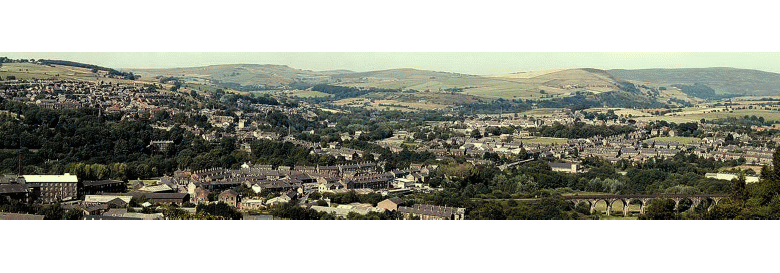| | | | |  | |  | | | |
BIRCH VALE CHIMNEY. August 18th 1893
Mr. John Faulkner, the well-known steeplejack of Manchester, is now engaged repairing the tall chimney belonging to Messrs. John Bennett and Sons Printworks, Birch Vale.
The chimney, he tells me, is 216 feet high, and was laddered in two and a half hours. On examination, the cramps, which secured the stonework, were found to be greatly the worse for wear, and it is necessary to replace them with new copper cramps; the joints of this stonecap will be pointed up, also the brickwork for 10 yards underneath will be pointed with boiled linseed oil mastic cement. This mastic cement which he uses, he finds to be better than any other cement or mortar for his class of work. It resists the sulphur and weather, and at the same time is absolutely waterproof, and when set is as hard as rock, almost unbreakable. Mr. Faulkner tells me he does not confine himself to tall mill chimneys, but can proudly say he has operated on most of the loftiest spires in the United Kingdom. Of course, the system of laddering a chimney or spire is not the original process; in fact it has only been in operation 17 or 18 years. Before then, kite flying was the modus operandi. Mr. Faulkner has the proud distinction of having been the first man to gain access to the top of a chimney by this means some forty years ago, and since then up to the present he has repaired some thousands of spires and chimneys; in fact, he can safely say he has been on more chimneys than any other man in the world.
This is by no means his first visit to this district, for he has recently repaired chimneys for Messrs. Slack, the Kinder Printing Company, Hayfield Printing Company, Woods', Glossop, Sumner and Company, Sidebottom's, Hadfield, Platts and Company, Rhodes' and Company, Potter and Company, Dinting Church, Whitfield Church, Old Glossop Church, Woods Baths and Hospital, Strines Printworks, etc.
At the present time he is erecting lightning conductors and repairing chimneys and spires at Royal Exchange and Owen's College, Manchester, Accrington several chimneys, Brackley Church, Northamptonshire, and has just been chosen by the directors of the Dukinfield Coal Company as the most suitable person (and deservedly too) to repair their chimney at Astley Pit, which was struck by lightning during the recent storms.
This chimney is 42 yards high, and was shattered about one-third its length. It is a wonder to me that such a stroke of lightning (which displace such a quantity of brickwork) did not level the whole chimney to the ground. Had there been an efficient lightning-conductor fixed on the chimney, this catastrophe would not have occurred, lightning conductors carry away the electric fluid silently and unseen to the ground. In all his experience he has never known a single case in which an efficient lightning conductor has ever failed to do its allotted duty.
Mr. Faulkner recommends all persons using lightning conductors on their buildings to keep them in good repair, and tested electrically to ascertain if they are in proper working order.
During his career he has straightened some scores of chimneys, some of which had been out of perpendicular from 1 foot to the alarming extent of 6 feet.
On the 10th of March, 1863, the day of the celebration of the Prince of Wales' wedding, he baked an immense potato pie (which weighed over 60Ibs.) on the cool side of the chimney belonging to the Manchester Corporation Gas works, Rochdale road. This chimney was 303 feet high, into which the heat from no less than 120 different fires was constantly ascending. During the whole of the time the chimney was thus working he contrived to remove the large stone cap of the chimney, weighing 40 tons, and 48 feet of the brickwork of the chimney.
I may mention that the Birch Vale chimney from the ground level to the summit is 216 feet high, and the foundation is 24 feet below ground level. It was built in 1851 by Clayton, of Hazel Grove, at a cost of £1,500. The bricks were made close by, the exact spot being across the reservoir bank, and were conveyed along a temporary tramway by means of a pony and wagons, the pony-driver at the time being, Mr. Thomas Ashton, now of Beard Wood, New Mills.
From High Peak Reporter
 |
| | ![]() |  | |  | | | | | |
|
|








